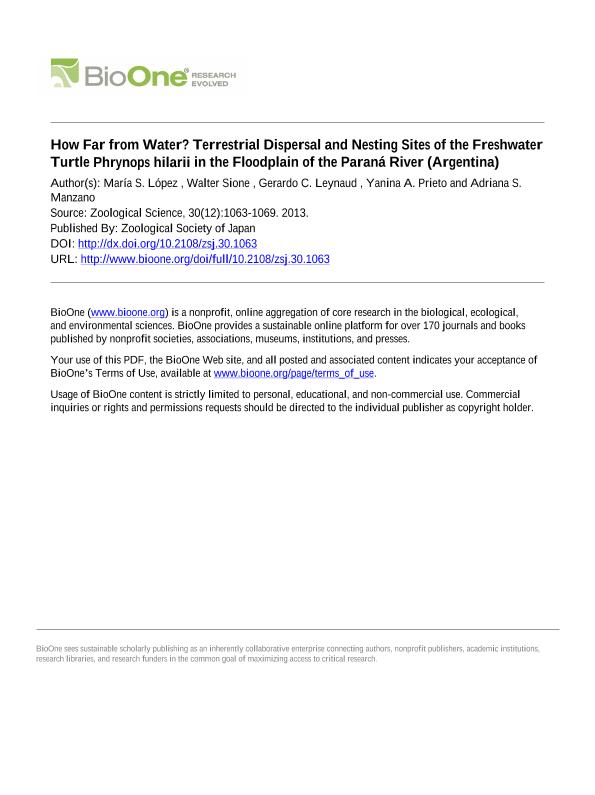Artículo
How far away from water? Terrestrial dispersal and nesting sites of the freshwater turtle Phrynops hilarii in the floodplain of the Paraná River (Argentina)
Lopez, Maria Soledad ; Sione, Walter Fabian; Leynaud, Gerardo Cristhian
; Sione, Walter Fabian; Leynaud, Gerardo Cristhian ; Prieto, Yanina
; Prieto, Yanina ; Manzano, Adriana Silvina
; Manzano, Adriana Silvina
 ; Sione, Walter Fabian; Leynaud, Gerardo Cristhian
; Sione, Walter Fabian; Leynaud, Gerardo Cristhian ; Prieto, Yanina
; Prieto, Yanina ; Manzano, Adriana Silvina
; Manzano, Adriana Silvina
Fecha de publicación:
08/2013
Editorial:
Zoological Society of Japan
Revista:
Zoological Science
ISSN:
0289-0003
Idioma:
Inglés
Tipo de recurso:
Artículo publicado
Clasificación temática:
Resumen
Terrestrial environments surrounding aquatic resources are important and intensively used by semi-aquatic species. In the present work, terrestrial dispersal and nesting sites of the freshwater turtle Phrynops hilarii were analyzed in the floodplain of the Paraná River, using field data and variables obtained from remote sensing. A total of 112 turtles and 44 nests were recorded during road sampling for one year (covered a total of 786 km in 30 surveys). Individuals were at a mean distance of 171.45 m from water, with a negative correlation between number of turtles and distance from water bodies. No significant differences in distance of turtles from water were observed among seasons. Phrynops hilarii nested at a mean distance of 136.51 m from water, showing a negative correlation between number of nests and distance from water bodies. Mean elevation of nests relative to maximum level of water body nearest each record was 1.13 m. The correlation between number of nests and elevation of the nearest water body was positive and significant. The landscape surrounding wetlands is important for P. hilarii to complete the life cycle, as nesting is done in this environment. Our results show that the habitat selected for nesting and terrestrial dispersal was proportionally different from that available in the entire study area, with a higher proportion of wetlands, grasslands and forests.
Palabras clave:
Dispersal
,
Freshwater Turtle
,
Habitat
,
Phrynops Hilarii
,
Nesting
Archivos asociados
Licencia
Identificadores
Colecciones
Articulos(CICYTTP)
Articulos de CENTRO DE INV.CIENT.Y TRANSFERENCIA TEC A LA PROD
Articulos de CENTRO DE INV.CIENT.Y TRANSFERENCIA TEC A LA PROD
Citación
Lopez, Maria Soledad; Sione, Walter Fabian; Leynaud, Gerardo Cristhian; Prieto, Yanina; Manzano, Adriana Silvina; How far away from water? Terrestrial dispersal and nesting sites of the freshwater turtle Phrynops hilarii in the floodplain of the Paraná River (Argentina); Zoological Society of Japan; Zoological Science; 30; 12; 8-2013; 1063-1069
Compartir
Altmétricas



